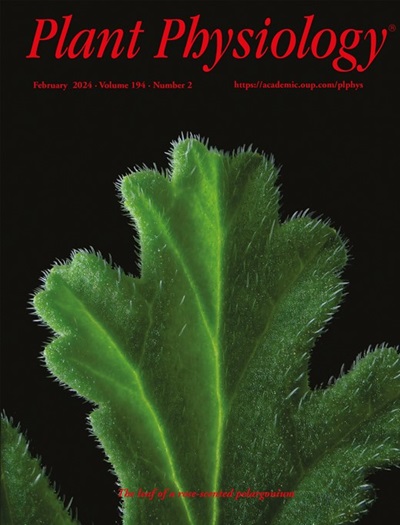HEADLESS represses a CYP735 monooxygenase gene and promotes iP-type cytokinin accumulation in the Medicago truncatula shoot apex
IF 6.5
1区 生物学
Q1 PLANT SCIENCES
引用次数: 0
Abstract
Cytokinins comprise a class of phytohormones that promote cell division and participate in diverse developmental processes. Cytokinin activity and steady-state levels in tissues are maintained through biosynthesis, signaling, degradation, side-chain modification, transport, and storage. Mutating HEADLESS (HDL), a Medicago truncatula homolog of Arabidopsis WUSCHEL (WUS), terminates the shoot apical meristem (SAM); thus, hdl mutants continuously generate leaves. In this study, we isolated a direct target of HDL [(HDL Target 1, HDT1)] based on RNA-seq transcriptome analyses using inducible HDL overexpression lines and the hdl mutant. HDT1 encodes a putative cytokinin hydroxylase homologous to Arabidopsis Cytochrome P450 monooxygenase CYP735A1 and CYP735A2. HDT1 trans-hydroxylates the prenyl side chain of cytokinins, converting the iP-type into tZ-type cytokinins. We show that HDL directly binds to the HDT1 promoter and represses its transcription, promoting the preferential accumulation of iP-type cytokinins. Overexpressing HDT1 slowed plant growth, leading to shorter plants caused by inhibited internode elongation, which is reminiscent of the hdl mutant phenotype albeit less severe. Both the hdl mutant and HDT1 overexpression lines accumulated lower levels of the iP-type but higher levels of the tZ-type cytokinins in shoots, indicating that HDT1 promotes tZ-type cytokinin biosynthesis and that HDL represses this process. Overall, this study uncovers the role of HDL in cytokinin biosynthesis and suggests that iP is preferred over tZ for SAM function in M. truncatula, opening avenues of research to better understand HDL function and the molecular mechanisms that regulate cytokinin biosynthesis.HEADLESS通过抑制一个CYP735单加氧酶基因,促进短茎尖ip型细胞分裂素的积累
细胞分裂素是一类促进细胞分裂并参与多种发育过程的植物激素。细胞分裂素在组织中的活性和稳态水平是通过生物合成、信号传导、降解、侧链修饰、运输和储存来维持的。拟南芥wuchel (WUS)的一种同源基因突变HEADLESS (HDL)终止了茎尖分生组织(SAM);因此,HDL突变体不断产生叶片。在这项研究中,我们利用可诱导的HDL过表达系和HDL突变体,基于RNA-seq转录组分析分离出HDL的直接靶点[HDL target 1, HDT1]。HDT1编码一种假定的细胞分裂素羟化酶,与拟南芥细胞色素P450单加氧酶CYP735A1和CYP735A2同源。HDT1反式羟基化细胞分裂素的烯丙基侧链,将ip型细胞分裂素转化为z型细胞分裂素。我们发现HDL直接结合HDT1启动子并抑制其转录,促进ip型细胞分裂素的优先积累。过表达HDT1会减缓植物生长,导致节间伸长受到抑制,植株变短,这让人想起hdl突变表型,尽管不那么严重。hdl突变体和HDT1过表达系在茎部积累了较低水平的ip型细胞分裂素,而较高水平的z型细胞分裂素,表明HDT1促进了z型细胞分裂素的生物合成,而hdl抑制了这一过程。总的来说,本研究揭示了高密度脂蛋白在细胞分裂素生物合成中的作用,并表明在短叶参中,iP比tZ更适合SAM功能,为更好地理解高密度脂蛋白功能和调节细胞分裂素生物合成的分子机制开辟了研究途径。
本文章由计算机程序翻译,如有差异,请以英文原文为准。
求助全文
约1分钟内获得全文
求助全文
来源期刊

Plant Physiology
生物-植物科学
CiteScore
12.20
自引率
5.40%
发文量
535
审稿时长
2.3 months
期刊介绍:
Plant Physiology® is a distinguished and highly respected journal with a rich history dating back to its establishment in 1926. It stands as a leading international publication in the field of plant biology, covering a comprehensive range of topics from the molecular and structural aspects of plant life to systems biology and ecophysiology. Recognized as the most highly cited journal in plant sciences, Plant Physiology® is a testament to its commitment to excellence and the dissemination of groundbreaking research.
As the official publication of the American Society of Plant Biologists, Plant Physiology® upholds rigorous peer-review standards, ensuring that the scientific community receives the highest quality research. The journal releases 12 issues annually, providing a steady stream of new findings and insights to its readership.
 求助内容:
求助内容: 应助结果提醒方式:
应助结果提醒方式:


